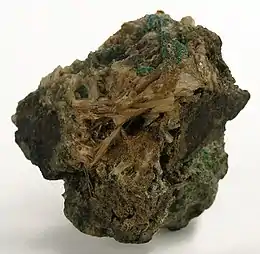Lanarkite
Lanarkite is a mineral, a form of lead sulfate with formula Pb2(SO4)O. It was originally found at Leadhills in the Scottish county of Lanarkshire, hence the name. It forms white or light green, acicular monoclinic prismatic crystals, usually microscopic in size. It is an oxidation product of galena.
| Lanarkite | |
|---|---|
 | |
| General | |
| Category | Sulfate minerals |
| Formula (repeating unit) | Pb2(SO4)O |
| IMA symbol | Lan[1] |
| Strunz classification | 7.BD.40 |
| Crystal system | Monoclinic |
| Crystal class | Prismatic (2/m) (same H-M symbol) |
| Space group | C2/m |
In 2023, Lanarkite was used by Korean physicists in an attempt to make LK-99, a material evaluated for room-temperature superconductivity.[2]
References
- Warr, L.N. (2021). "IMA–CNMNC approved mineral symbols". Mineralogical Magazine. 85 (3): 291–320. Bibcode:2021MinM...85..291W. doi:10.1180/mgm.2021.43. S2CID 235729616.
- Bob Yirka, Korean team claims to have created the first room-temperature, ambient-pressure superconductor, Phys Org, 27 July 2023
Wikimedia Commons has media related to Lanarkite.
This article is issued from Wikipedia. The text is licensed under Creative Commons - Attribution - Sharealike. Additional terms may apply for the media files.